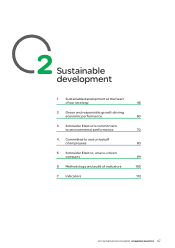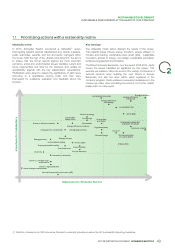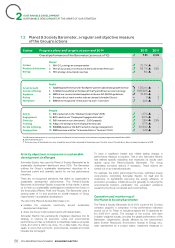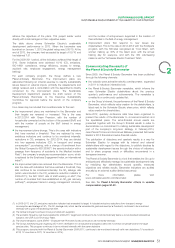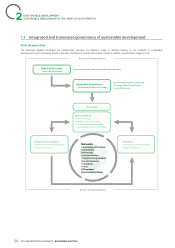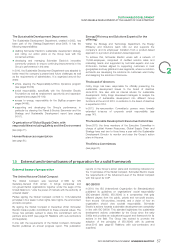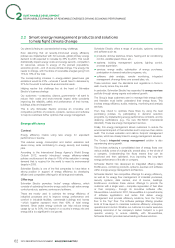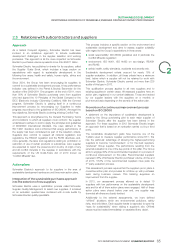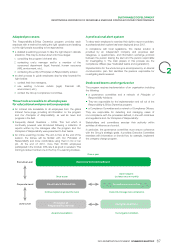APC 2013 Annual Report Download - page 59
Download and view the complete annual report
Please find page 59 of the 2013 APC annual report below. You can navigate through the pages in the report by either clicking on the pages listed below, or by using the keyword search tool below to find specific information within the annual report.
SUSTAINABLE DEVELOPMENT
SUSTAINABLE DEVELOPMENT AT THE HEART OF OUR STRATEGY
The Sustainable Development Department Energy Efficiency and Solutions Experts (for the
offering)
The Sustainable Development Department, created in2002, has
been part of the StrategyDepartment since2008. It has the Within the Strategy and Technology Department, the Energy
following responsibilities: Efficiency and Solutions team rolls out and supports the
company’s and its employees’ transition from a product-based
defining Schneider Electric’s sustainable development strategy
l
approach to a product-and-solution-based approach.
and rolling out action plans at the Group level with the
concerned entities; To achieve this, Schneider Electric works with a network of
15,000employees, comprised of certified solution sales and
developing and managing Schneider Electric’s innovative
l
marketing teams and supported by technical experts and over
community projects to ensure continuing improvements in the 60Solution Centers aligned to supporting customers in local
Group’s performance in this area.
2
geographies and key global end user segments, where our solution
In2010, the Sustainable Development Department was adapted to architects are developing the solutions its customers want today
better meet the company’s present and future challenges as well and designing the solutions of tomorrow.
as the requirements of stakeholders. It is organized around four
The board of directors
areas:
ethics, steering the Responsibility&Ethics Dynamics program
l
Cathy Kopp has been responsible for officially presenting the
(see pages 66-69); sustainable development issues to the board of directors
social responsibility, specifically with the Schneider Electric
l
since2010. She also acts as internal advisor for sustainable
Foundation as well as employment opportunity and expansion development: Cathy Kopp interviewed managers to analyze the
programs (see pages99-104); integration of sustainable development into different Group
access to energy, responsibility for the BipBop program (see
l
functions at the end of 2013. A restitution to the board of directors
pages94-99); is expected in 2014.
supporting and developing the Group’s performance, in
l
In2013, theremuneration Committee’s powers were formally
particular by steering the Planet&Society Barometer and the extended toissues of corporate social responsibility (see
Strategy and Sustainable Development report (see pages page141).
50-51).
The Sustainable Development Executive Committee
Organization of Global Supply Chain, with
responsibilities including Safety and the Environment
Since2010, the three members of the Executive Committee in
charge of global Human Resources, Global Supply Chain and
(seepage 71). Strategy have met two to three times a year with the Sustainable
Human Resources organization
Development Director to monitor and steer the Group’s action
plans in this area.
(seepage 81).
The Ethics Committees
(see page67).
External and internal bases of preparation for a solid framework
1.5
External bases of preparation
reports on the Group’s action plans and monitoring indicators for
the 10 principles of the Global Compact. Schneider Electric meets
The United Nations Global Compact
the requirements of the Advanced Level of the Global Compact
with this report for COP.
The Global Compact was launched in1999 by UN
ISO26000
Secretary-General Kofi Annan. It brings companies and
non-governmental organizations together under the aegis of the In2010, the ISO (International Organization for Standardization)
United Nations to “unite the power of markets with the authority of published its guidelines on organizations’ social responsibility
universal ideals”. (ISOstandard 26000). ISO26000 is a compromise that gets
Parties signing the Global Compact commit to 10fundamental different players from the public, private and non-profit sectors,
principles in four areas: human rights, labor rights, the environment from around 100countries, involved, and a vision of how an
and anti-corruption. organization should view societal responsibility. Schneider
Electric’s actions towards sustainable development are completely
By signing the Global Compact in December 2002, Schneider in line with ISO26000. This standard legitimizes the sustainable
Electric made a public commitment to these universal values. The development actions undertaken by the Group since the early
Group has primarily worked to share this commitment with its 2000s and provides an educational support and framework for its
partners since2003 (see page56 Relations with sub-contractors actions in the field. The Group has worked to promote the
and suppliers). adoption of the principles of ISO26000 with its partners
In line with the requirements of the Global Compact, Schneider since2012 (see page65 Relations with sub-contractors and
Electric publishes an annual progress report. This publication suppliers).
57
2013 REGISTRATION DOCUMENT SCHNEIDER ELECTRIC


